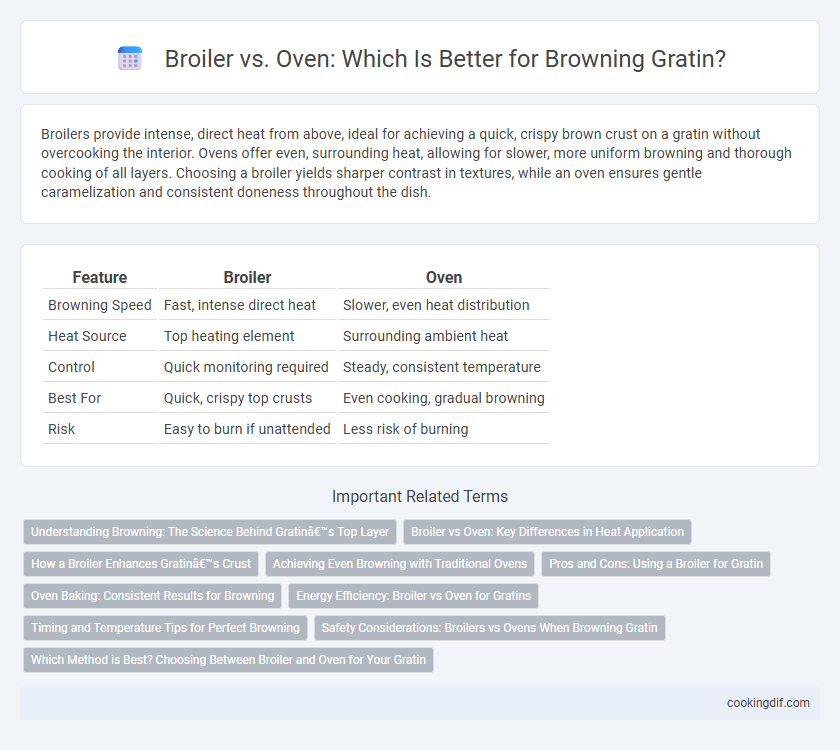Broilers provide intense, direct heat from above, ideal for achieving a quick, crispy brown crust on a gratin without overcooking the interior. Ovens offer even, surrounding heat, allowing for slower, more uniform browning and thorough cooking of all layers. Choosing a broiler yields sharper contrast in textures, while an oven ensures gentle caramelization and consistent doneness throughout the dish.
Table of Comparison
| Feature | Broiler | Oven |
|---|---|---|
| Browning Speed | Fast, intense direct heat | Slower, even heat distribution |
| Heat Source | Top heating element | Surrounding ambient heat |
| Control | Quick monitoring required | Steady, consistent temperature |
| Best For | Quick, crispy top crusts | Even cooking, gradual browning |
| Risk | Easy to burn if unattended | Less risk of burning |
Understanding Browning: The Science Behind Gratin’s Top Layer
Broiling uses intense, direct heat from above to rapidly brown gratin's top layer, triggering the Maillard reaction and caramelization that create a crisp, golden crust. Ovens provide even, ambient heat that cooks the gratin thoroughly but may require finishing under the broiler to achieve the desired browning effect. Mastering the balance between oven baking and broiling enhances the gratin's texture and flavor through optimal browning science.
Broiler vs Oven: Key Differences in Heat Application
The broiler applies intense, direct radiant heat from above, rapidly browning the gratin's surface and creating a crisp, golden crust. In contrast, the oven provides gentle, ambient heat surrounding the dish evenly, which cooks the gratin thoroughly but results in a more uniform, less intensely browned top layer. Choosing between broiler and oven depends on the desired texture: broiler excels at quick surface caramelization, while oven ensures consistent heat penetration for even cooking.
How a Broiler Enhances Gratin’s Crust
A broiler intensifies heat from above, rapidly caramelizing cheese and breadcrumbs for a golden, crispy gratin crust. This direct, high temperature accelerates Maillard reactions, producing deeper color and complex flavors compared to conventional oven baking. Using a broiler ensures a perfect balance of creamy interior with a crunchy, well-browned top layer.
Achieving Even Browning with Traditional Ovens
Traditional ovens provide consistent and controlled heat distribution, making them ideal for achieving even browning on gratin dishes. Unlike broilers, which apply intense direct heat primarily from above, ovens cook with surrounding heat, allowing the cheese and breadcrumbs to brown uniformly without burning. Using a traditional oven at the right temperature ensures a perfectly golden crust and creamy interior for gratin.
Pros and Cons: Using a Broiler for Gratin
Using a broiler for gratin delivers rapid, intense heat that efficiently browns the top layer, creating a crisp, golden crust in minutes. However, broilers can cause uneven cooking or quick burning if not closely monitored, requiring constant attention to avoid charred spots. Compared to an oven, a broiler works best for finishing dishes rather than thorough baking, making it ideal for gratin toppings but less effective for cooking the entire dish evenly.
Oven Baking: Consistent Results for Browning
Oven baking ensures consistent browning for gratin by providing even, controlled heat distribution essential for achieving a golden, crispy top layer. Unlike broilers, which apply intense, direct heat that can cause uneven browning or burning, ovens maintain steady temperatures that enhance the Maillard reaction across the dish's surface. This precise temperature control in oven baking results in uniform caramelization and optimal texture throughout the gratin.
Energy Efficiency: Broiler vs Oven for Gratins
Broilers concentrate intense, direct heat from above, enabling rapid browning and reducing overall cooking time for gratins, which can lead to energy savings compared to slower, all-around heating in ovens. Ovens provide uniform heat distribution, but the longer cooking duration often results in higher energy consumption when aiming for a golden gratin crust. Selecting a broiler for the final browning stage maximizes energy efficiency by minimizing cooking time while achieving optimal caramelization on gratins.
Timing and Temperature Tips for Perfect Browning
For perfect browning in a gratin, using a broiler typically requires higher temperatures around 500degF and shorter cooking times of 2-5 minutes, delivering intense direct heat for a crisp, golden crust. An oven set to 400degF offers more even, gentle browning over 20-30 minutes, ideal for thoroughly cooking the dish while developing a deep, caramelized top. Monitoring closely is essential with a broiler to prevent burning, while the oven allows for gradual browning and better heat distribution.
Safety Considerations: Broilers vs Ovens When Browning Gratin
Broilers reach higher temperatures and provide intense, direct heat ideal for browning gratin quickly while requiring close monitoring to prevent burning and potential fire hazards. Ovens offer more controlled and even heat distribution, reducing the risk of overheating or splattering but may require longer cooking times to achieve the desired browning effect. Using an oven ensures safer operation for extended cooking, while broilers demand vigilant supervision due to their rapid and concentrated heat output.
Which Method is Best? Choosing Between Broiler and Oven for Your Gratin
The broiler provides intense, direct heat ideal for quick, evenly browned gratin tops with a crisp texture. The oven offers gentler, consistent heat throughout the dish, ensuring thorough cooking and gradual browning. For the best results, use the oven to cook the gratin evenly and finish with the broiler to achieve a golden, crispy crust.
Broiler vs Oven for browning Infographic

 cookingdif.com
cookingdif.com